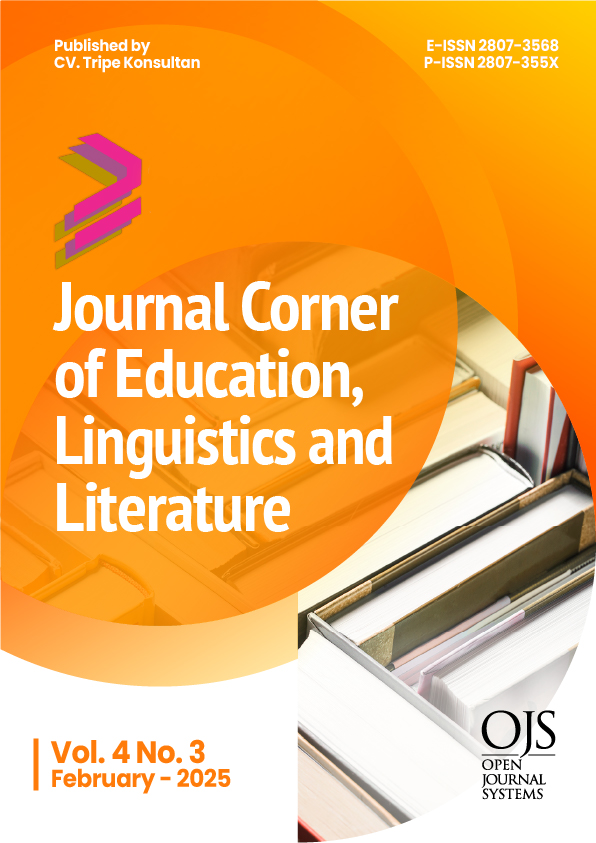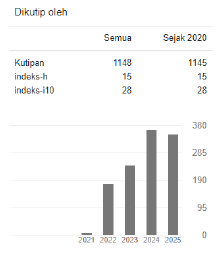The Influence of Globalisation on the Shift in Local Language and Cultural Identity
 https://doi.org/10.54012/jcell.v4i3.435
https://doi.org/10.54012/jcell.v4i3.435
 Abstract views: 2320
Abstract views: 2320
 PDF downloads: 1967
PDF downloads: 1967
Keywords:
cultural identity, globalisation, regional languages, social mediaAbstract
Globalisation led to significant changes in the use of regional languages and local cultural identities, particularly in Indonesia, a country renowned for its linguistic and cultural diversity. This study aimed to analyse the impact of globalisation on the decline in regional language use, identify the factors that influenced the shift in local cultural identity, and explore adaptive strategies to preserve language and culture in the digital era. Employing a descriptive qualitative approach with a literature analysis method, this research examined various academic journals, books, and research reports published within the past decade. The findings indicated that globalisation significantly contributed to the decline in the number of regional language speakers, with Indonesian and foreign languages increasingly dominating daily communication. Furthermore, global culture, disseminated through social media and the entertainment industry, shifted young people’s interest away from local traditions. However, this study also highlighted the potential of social media as a tool for revitalising local languages and cultures, with various digital initiatives successfully raising public awareness of cultural preservation. Strategies to sustain local language and culture included integrating regional languages into education, utilising digital technology, implementing government policies, promoting cultural awareness campaigns, and fostering collaboration with the creative industries. Nevertheless, this study had limitations, as it did not incorporate direct field data. Therefore, future research was recommended to adopt ethnographic approaches and quantitative analysis to measure the long-term effectiveness of digital strategies. The findings of this study were expected to serve as a reference for policymakers, educators, and cultural communities in formulating strategies to safeguard local languages and cultural heritage amidst the pressures of globalisation.
Downloads
References
Amalia Solikhah, N. (2023). Impact of Technology in Teaching and Learning English as Foreign Language : TESOL Context. Journal Corner of Education, Linguistics, and Literature, 3(1), 83–91. https://doi.org/10.54012/jcell.v3i1.194
Amaral, G., Bushee, J., Cordani, U. G., KAWASHITA, K., Reynolds, J. H., ALMEIDA, F. F. M. D. E., de Almeida, F. F. M., Hasui, Y., de Brito Neves, B. B., Fuck, R. A., Oldenzaal, Z., Guida, A., Tchalenko, J. S., Peacock, D. C. P., Sanderson, D. J., Rotevatn, A., Nixon, C. W., Rotevatn, A., Sanderson, D. J., … Junho, M. do C. B. (2017). Transition: A Positive Start to School. Journal of Petrology, 369(1), 1689–1699. https://doi.org/10.1017/CBO9781107415324.004
Amin, A. (2020). Attitude Towards Language in Sociolinguistics Settings: A Brief Overview. REiLA : Journal of Research and Innovation in Language, 2(1), 27–30. https://doi.org/10.31849/reila.v2i1.3758
Appadurai, A. (2020). Modernity at large: Cultural dimensions of globalization. University of Minnesota Press.
Apriyanto, S., & Nurhayaty, A. (2019). Born In Social Media Culture: Personality Features Impact In Communication Context. In Y. Nasucha (Ed.), icollit (pp. 167–175). UMS Press. icollit.ums.ac.id/2018
Counihan, C., & Esterik, P. Van. (2013). Food and culture: A reader (3rd ed). Routledge. https://doi.org/10.1002/(sici)1520-6300(1999)11:3<411::aid-ajhb12>3.0.co;2-h
Crystal, D. (2018). Language death. Cambridge University Press.
Dewi, U. P., & Setiadi, C. J. (2018). Language Attitude and Language Choice in Bilingual Academic Learning Environment. Lingua Cultura, 12(4), 369. https://doi.org/10.21512/lc.v12i4.4288
Diako, M. (2012). Discourses on Autonomy and Marital Satisfacton Among Black Women in Dual-Career Marriages (Issue October). University of Pretoria.
Edwards, J. (2020). Language, society and identity. Cambridge University Press.
Fishman, J. A. (2018). Reversing language shift: Theoretical and empirical foundations of assistance to threatened languages. Multilingual Matters.
Galdia, M. (2017). Lectures on Legal Linguistics. Peter Lang Edition. https://doi.org/DOI 10.3726/b11443
Galperin, B. L., & Lituchy, T. R. (2014). Human Resource Development in Service Firms Across Cultures. Human Resource Development Review, 13(3), 336–368. https://doi.org/10.1177/1534484313511971
Gao, H., & Prime, P. (2010). Facilitators and Obstacles of Intercultural Business Communication for American Companies in China: Lessons Learned from the UPS Case. Global Business Languages. 2010, 15(10), 143–169. http://docs.lib.purdue.edu/cgi/viewcontent.cgi?article=1195&context=gbl
Giddens, A. (2019). The consequences of modernity. Polity Press.
Harrison, K. D. (2021). When languages die: The extinction of the world's languages and the erosion of human knowledge. Oxford University Press.
Henderson, J. C. (2021). Tourism and cultural heritage in Southeast Asia. Routledge.
Hylland Eriksen, T. (2020). Globalization: The key concepts. Bloomsbury Publishing.
Kim, Y. (2019). Globalization and cultural trends in South Korea. Routledge.
Kusuma, H. A., & Apriyanto, S. (2018). Strategy on Developing English Learning Material for Specific Purposes. IJECA (International Journal of Education and Curriculum Application), 1(3), 39. https://doi.org/10.31764/ijeca.v1i3.2144
Lauder, A. F. (2019). Language shift and maintenance in Indonesia: A sociolinguistic perspective. Journal of Indonesian Linguistics, 14(2), 45-62.
Lears, T. J. J. (2016). The Concept of Cultural Hegemony : Problems and Possibilities Author ( s ): T . J . Jackson Lears Source : The American Historical Review , Vol . 90 , No . 3 ( Jun ., 1985 ), pp . 567-593 Published by : Oxford University Press on behalf of the American Hi. Oxford Journals, 90(3), 567–593.
Maatougui, L. (2014). The American Cultural Hegemony as a process of Globalization. Muhammad Khaider University of Biskra.
Natarova, T. (2011). Intercultural communication experiences of foreign students with a focus on their perspectives of national, cultural and ethnic identity: Case of Exchange and Degree Students in Jyväskylä, Finland. Master’s Thesis. December. https://jyx.jyu.fi/dspace/bitstream/handle/123456789/37101/URN:NBN:fi:jyu-2011121811816.pdf?sequence=1
Nihal. (2010). Using Drama in Teaching English for Young Learners. SELÇUK ÜNİVERSİTESİ.
Skutnabb-Kangas, T. (2020). Linguistic genocide in education – or worldwide diversity and human rights? Routledge.
Spolsky, B. (2019). Language policy. Cambridge University Press.
Tan, L., & Lee, J. (2020). Social media as a tool for language and cultural preservation. Digital Culture & Society, 6(1), 78-95.
Thomason, S. G. (2001). Language Contact. Edinburgh University Press Ltd. https://doi.org/10.1016/B978-0-08-097086-8.53016-5
UNESCO. (2021). Atlas of the world’s languages in danger. United Nations Educational, Scientific and Cultural Organization.
Van Der Borg, J., Russo, A. P., Lavanga, M., & Mingardo, G. (2005). The impacts of culture on the economic development of cities. European Institute for Comparative Urban Research (EURICUR) Erasmus University Rotterdam, 1–395. https://doi.org/10.1109/ISVRI.2011.5759606
Yahaya, A., Yahaya, N., Ramli, J., Hashim, S., & Zakariya, Z. (2010). The Effects of Various Modes of School Formality Culture and Student Learning Style with Secondary School Students Academic’s Achievements. International Journal of Psychological Studies, 2(1), 96–106. https://doi.org/10.5539/ijps.v2n1p96
Downloads
Published
How to Cite
Issue
Section
License
Copyright (c) 2025 Kasiyarno, Sigit Apriyanto

This work is licensed under a Creative Commons Attribution-ShareAlike 4.0 International License.
All articles published in the Journal Corner of Education, Linguistics, and Literature are licensed under the Creative Commons Attribution-ShareAlike License (CC BY-SA).

















